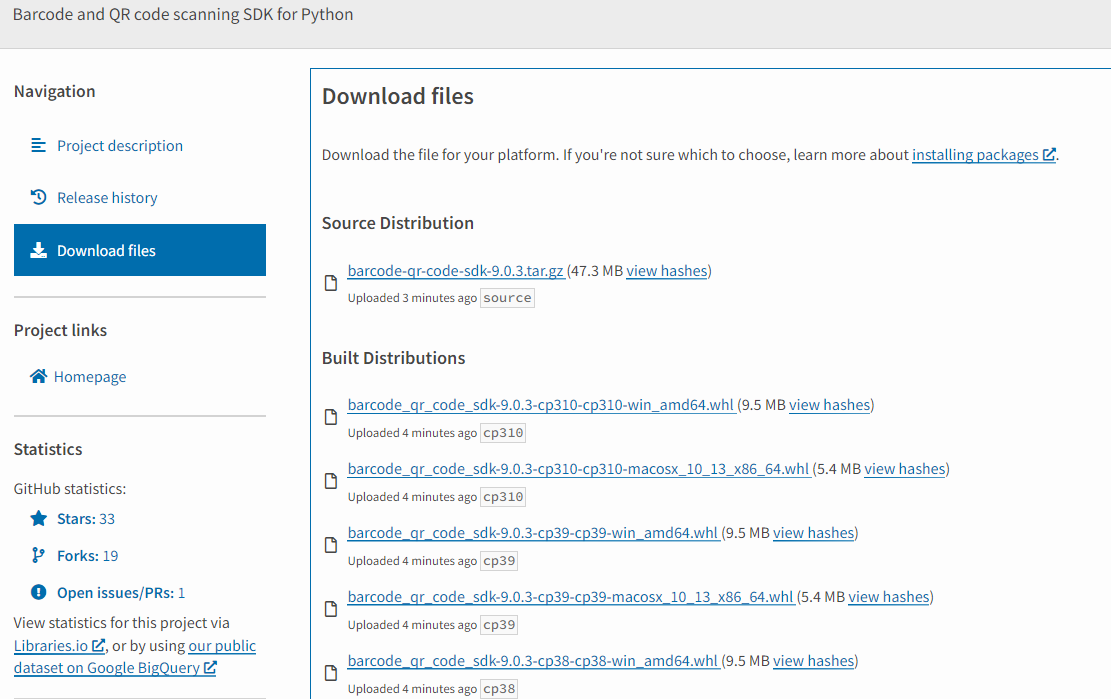Using GitHub Action to Build Python Wheel Package for Dynamsoft Barcode Reader
Implementing a Python extension in C or C++ is easy, but building the native module into a Python wheel package for different operating systems and different Python versions is a nightmare. A CPython wheel package is Python-version-dependent, therefore, to make a CPython module work universally for Python 3.x, you have to build wheels for Python 3.6, Python 3.7, Python 3.8, Python 3.9, and Python 3.10 per operating system. The maximum amount of packages equals to Python versions (3.6, 3.7, 3.8, 3.9, 3.10) * operating systems (Windows, Linux, macOS) * CPU architectures (x64, aarch64). To simplify the process, we can utilize GitHub Actions. In this article, we take Dynamsoft C/C++ Barcode SDK as an example. You will see how to build a CPython extension that links to external C/C++ libraries (*.dll, *.so, *.dylib), and how to automate the process of building and publishing the Python wheel package with GitHub Actions.
Requirements
Dynamsoft C/C++ Barcode SDK v9.0
Building CPython Extension Project with Scikit-build
If you have read Python development guide, you may know that distutils.core.Extension is the most widely used Python extension builder. However, distutils cannot sequentially build the extension and package the generated library with the package folder when running the pip wheel command for creating a wheel package.
Scikit-build is an alternative to distutils. It extends distutils functions with CMake build. To get started with scikit-build, we can visit scikit-build-sample-projects.
For our Python barcode and QR code extension project, the setup.py file is as follows:
from skbuild import setup
import io
packages = ['barcodeQrSDK']
setup (name = 'barcode-qr-code-sdk',
version = '9.0.3',
description = 'Barcode and QR code scanning SDK for Python',
packages=packages,
include_package_data=False,
)
As you can see, the setup.py file is pretty simple comparing to the setup.py file used with disutils. It only contains the package folder. To trigger extension build, we create a CMakeLists.txt along with the setup.py file.
cmake_minimum_required(VERSION 3.4...3.22)
project(barcodeQrSDK)
find_package(PythonExtensions REQUIRED)
if(CMAKE_HOST_UNIX)
if(CMAKE_HOST_APPLE)
SET(CMAKE_CXX_FLAGS "-std=c++11 -O3 -Wl,-rpath,@loader_path")
SET(CMAKE_INSTALL_RPATH "@loader_path")
else()
SET(CMAKE_CXX_FLAGS "-std=c++11 -O3 -Wl,-rpath=$ORIGIN")
SET(CMAKE_INSTALL_RPATH "$ORIGIN")
endif()
SET(CMAKE_INSTALL_RPATH_USE_LINK_PATH TRUE)
endif()
MESSAGE( STATUS "CPU architecture ${CMAKE_SYSTEM_PROCESSOR}" )
if(CMAKE_HOST_WIN32)
link_directories("${PROJECT_SOURCE_DIR}/lib/win/")
elseif(CMAKE_SYSTEM_NAME STREQUAL "Linux")
if (CMAKE_SYSTEM_PROCESSOR STREQUAL x86_64)
MESSAGE( STATUS "Link directory: ${PROJECT_SOURCE_DIR}/lib/linux/" )
link_directories("${PROJECT_SOURCE_DIR}/lib/linux/")
elseif(CMAKE_SYSTEM_PROCESSOR STREQUAL armv7l)
MESSAGE( STATUS "Link directory: ${PROJECT_SOURCE_DIR}/lib/arm32/" )
link_directories("${PROJECT_SOURCE_DIR}/lib/arm32/")
elseif(CMAKE_SYSTEM_PROCESSOR STREQUAL aarch64)
MESSAGE( STATUS "Link directory: ${PROJECT_SOURCE_DIR}/lib/aarch64/" )
link_directories("${PROJECT_SOURCE_DIR}/lib/aarch64/")
endif()
elseif(CMAKE_HOST_APPLE)
MESSAGE( STATUS "Link directory: ${PROJECT_SOURCE_DIR}/lib/macos/" )
link_directories("${PROJECT_SOURCE_DIR}/lib/macos/")
endif()
include_directories("${PROJECT_BINARY_DIR}" "${PROJECT_SOURCE_DIR}/include/")
add_library(${PROJECT_NAME} MODULE src/barcodeQrSDK.cpp)
if(CMAKE_HOST_WIN32)
if(CMAKE_CXX_COMPILER_ID STREQUAL "GNU")
target_link_libraries (${PROJECT_NAME} "DynamsoftBarcodeReaderx64")
else()
target_link_libraries (${PROJECT_NAME} "DBRx64")
endif()
else()
target_link_libraries (${PROJECT_NAME} "DynamsoftBarcodeReader" pthread)
endif()
if(CMAKE_HOST_WIN32)
add_custom_command(TARGET ${PROJECT_NAME} POST_BUILD
COMMAND ${CMAKE_COMMAND} -E copy_directory
"${PROJECT_SOURCE_DIR}/lib/win/"
$<TARGET_FILE_DIR:${PROJECT_NAME}>)
endif()
python_extension_module(barcodeQrSDK)
install(TARGETS barcodeQrSDK LIBRARY DESTINATION barcodeQrSDK)
if(CMAKE_HOST_WIN32)
install (DIRECTORY "${PROJECT_SOURCE_DIR}/lib/win/" DESTINATION barcodeQrSDK)
elseif(CMAKE_SYSTEM_NAME STREQUAL "Linux")
if (CMAKE_SYSTEM_PROCESSOR STREQUAL x86_64)
install (DIRECTORY "${PROJECT_SOURCE_DIR}/lib/linux/" DESTINATION barcodeQrSDK)
elseif(CMAKE_SYSTEM_PROCESSOR STREQUAL armv7l OR ARM32_BUILD)
install (DIRECTORY "${PROJECT_SOURCE_DIR}/lib/arm32/" DESTINATION barcodeQrSDK)
elseif(CMAKE_SYSTEM_PROCESSOR STREQUAL aarch64)
install (DIRECTORY "${PROJECT_SOURCE_DIR}/lib/aarch64/" DESTINATION barcodeQrSDK)
endif()
elseif(CMAKE_HOST_APPLE)
install (DIRECTORY "${PROJECT_SOURCE_DIR}/lib/macos/" DESTINATION barcodeQrSDK)
endif()
What we do in the CMakeLists.txt file:
- Set build arguments. The
rpathis critical for finding dependent shared libraries on Linux and macOS. - Set the directories of header files and libraries.
- Build the extension module.
- Link external dynamic libraries.
- Copy the Python module and dependent libraries to the
barcodeQrSDKpackage folder.
A __init__.py file is also required in the barcodeQrSDK package folder.
from .barcodeQrSDK import *
__version__ = version
Run python setup.py develop command to test the extension module. If there is no error, we can create the wheel package:
pip wheel .
Once the wheel package is built successfully, its folder structure is like this:
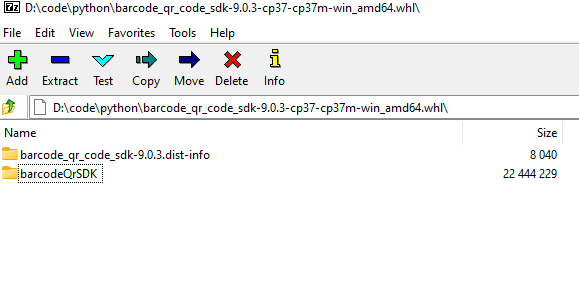
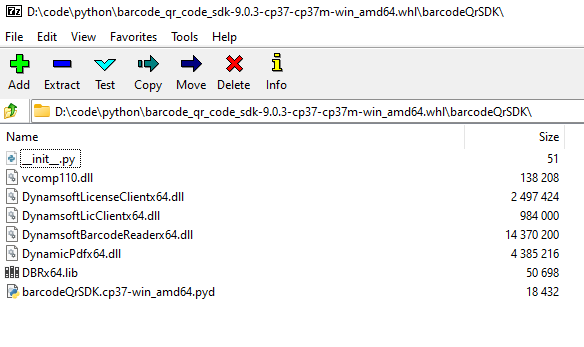
Creating Multiple Wheel Packages with GitHub Actions
As we have mentioned above, it drives us crazy to create multiple wheel packages for each version of Python and different platforms. Fortunately, GitHub Actions can relieve us a lot of work.
Here are the steps to build and publish multiple wheel packages:
- Go to the repository homepage and click
Actionsto create a new workflow. -
Click
set up a workflow yourselfto create a custom workflow. We can refer to the examples provided by cibuildwheel.name: Build and upload to PyPI on: [push, pull_request] jobs: build_wheels: name: Build wheels on $ runs-on: $ strategy: matrix: os: [windows-2019, macos-10.15] steps: - uses: actions/checkout@v2 - name: Build wheels uses: pypa/cibuildwheel@v2.5.0 env: CIBW_ARCHS_WINDOWS: AMD64 CIBW_ARCHS_MACOS: x86_64 CIBW_ARCHS_LINUX: "x86_64 aarch64" CIBW_SKIP: "pp* *-win32 *-manylinux_i686" - uses: actions/upload-artifact@v2 with: path: ./wheelhouse/*.whl build_sdist: name: Build source distribution runs-on: ubuntu-latest steps: - uses: actions/checkout@v2 - name: Build sdist run: pipx run build --sdist - uses: actions/upload-artifact@v2 with: path: dist/*.tar.gz upload_pypi: needs: [build_wheels, build_sdist] runs-on: ubuntu-latest # upload to PyPI on every tag starting with 'v' if: github.event_name == 'push' && startsWith(github.ref, 'refs/tags/v') # alternatively, to publish when a GitHub Release is created, use the following rule: # if: github.event_name == 'release' && github.event.action == 'published' steps: - uses: actions/download-artifact@v2 with: name: artifact path: dist - uses: pypa/gh-action-pypi-publish@v1.4.2 with: user: __token__ password: $ skip_existing: trueSince our extension is 64-bit only, we can skip 32-bit builds by setting
CIBW_SKIP: "pp* *-win32 *-manylinux_i686". We can also specify the OS architectures:CIBW_ARCHS_WINDOWS: AMD64 CIBW_ARCHS_MACOS: x86_64 CIBW_ARCHS_LINUX: "x86_64 aarch64" -
Go to
Settings > Secrets > Actionsto create a repository secret for publishing the wheel packages to pypi.org.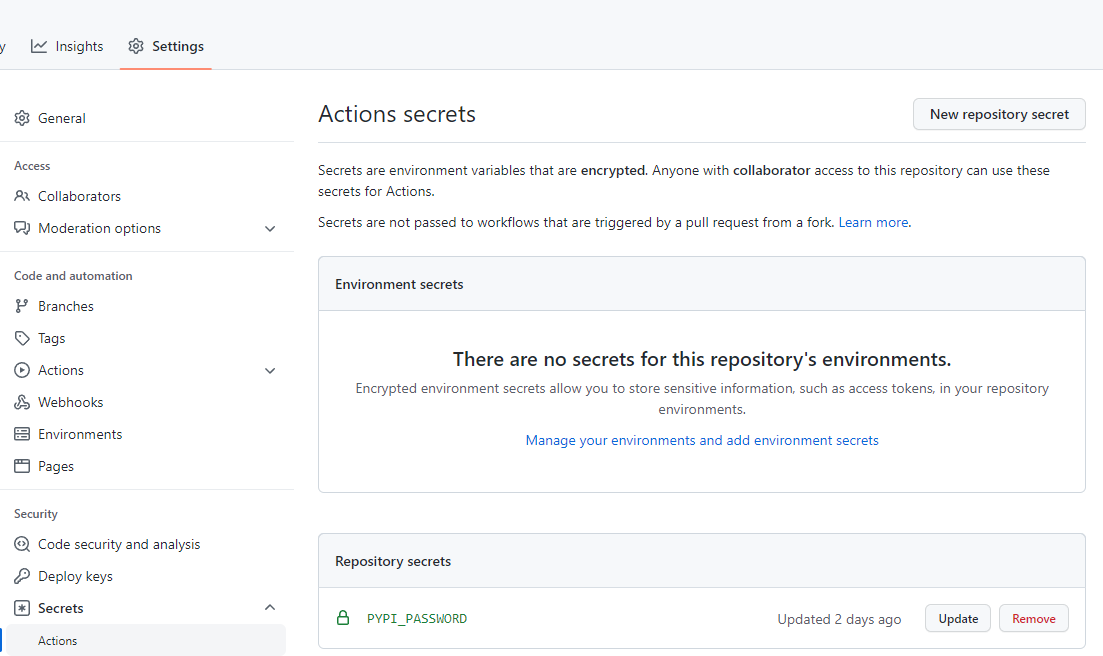
-
After finishing the workflows, we can download the artifact that contains the generate wheel packages.
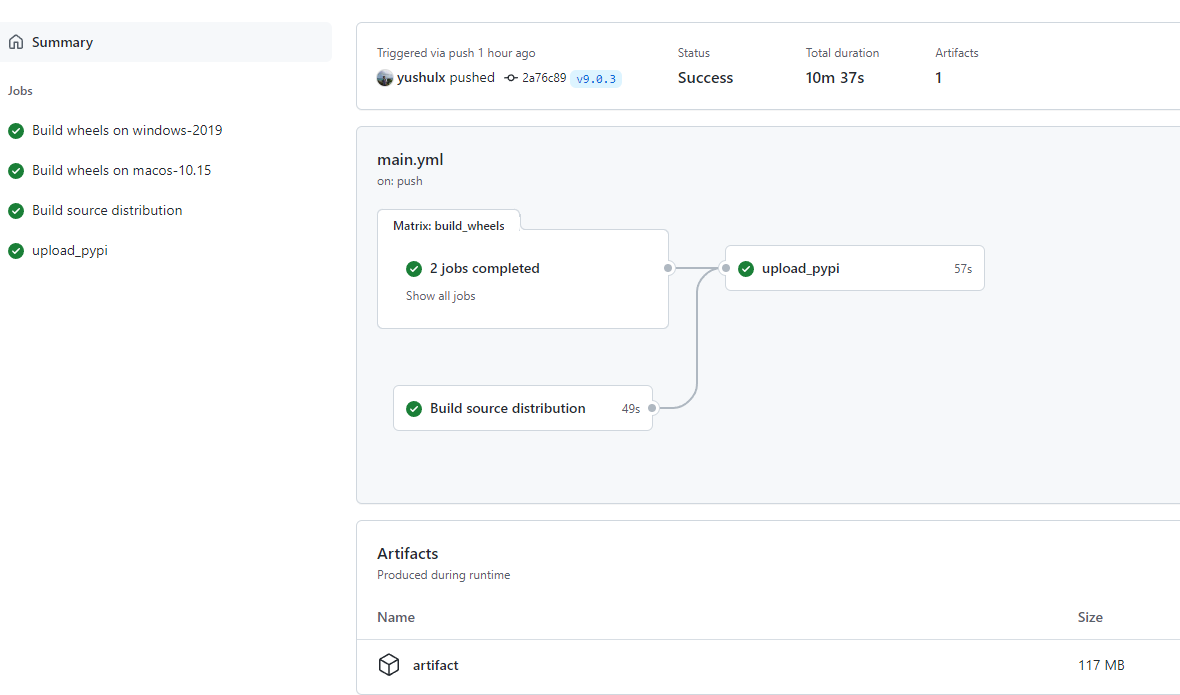
Besides, the wheel packages are available for download on pypi.org.
